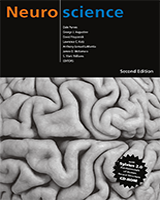By agreement with the publisher, this book is accessible by the search feature, but cannot be browsed.
NCBI Bookshelf. A service of the National Library of Medicine, National Institutes of Health.
Purves D, Augustine GJ, Fitzpatrick D, et al., editors. Neuroscience. 2nd edition. Sunderland (MA): Sinauer Associates; 2001.

Neuroscience. 2nd edition.
Show detailsSome years ago, a poll showed that 84% of psychologists agreed with the statement that “everything we learn is permanently stored in the mind, although sometimes particular details are not accessible.” The 16% who thought otherwise should get the higher marks. Common sense indicates that, were it not for forgetting, our brains would be impossibly burdened with the welter of useless information that is briefly encoded in our immediate memory “buffer.” In fact, the human brain is very good at forgetting. In addition to the unreliable performance on tests such as the example in Table 31.1, Figure 31.5 shows that the memory of the appearance of a penny (an icon seen thousands of times since childhood) is uncertain at best, and that people gradually forget what they have seen over the years (TV shows, in this case). Clearly we forget things that have no importance, and unused memories deteriorate over time.

Figure 31.5
Forgetting. (A) Different versions of the “heads” side of a penny. Despite innumerable exposures to this familiar design, few people are able to pick out (a) as the authentic version. Clearly, repeated information is not necessarily retained. (more...)
The ability to forget unimportant information may be as critical for normal mentation as retaining information that is significant. One reason for this presumption is rare individuals who have difficulty with the normal erasure of information. Perhaps the best-known case is a subject studied over several decades by the Russian psychologist A. R. Luria, who referred to the subject simply as “S.” Luria's description of an early encounter gives some idea why S, then a newspaper reporter, was so interesting:
I gave S a series of words, then numbers, then letters, reading them to him slowly or presenting them in written form. He read or listened attentively and then repeated the material exactly as it had been presented. I increased the number of elements in each series, giving him as many as thirty, fifty, or even seventy words or numbers, but this too, presented no problem for him. He did not need to commit any of the material to memory; if I gave him a series of words or numbers, which I read slowly and distinctly, he would listen attentively, sometimes ask me to stop and enunciate a word more clearly, or, if in doubt whether he had heard a word correctly, would ask me to repeat it. Usually during an experiment he would close his eyes or stare into space, fixing his gaze on one point; when the experiment was over, he would ask that we pause while he went over the material in his mind to see if he had retained it. Thereupon, without another moment's pause, he would reproduce the series that had been read to him.
A. R. Luria (1987), The Mind of a Mnemonist, pp. 9–10
S's phenomenal memory, however, did not always serve him well. He had difficulty ridding his mind of the trivial information that he tended to focus on, sometimes to the point of incapacitation. As Luria put it:
Thus, trying to understand a passage, to grasp the information it contains (which other people accomplish by singling out what is most important) became a tortuous procedure for S, a struggle against images that kept rising to the surface in his mind. Images, then, proved an obstacle as well as an aid to learning in that they prevented S from concentrating on what was essential. Moreover, since these images tended to jam together, producing still more images, he was carried so far adrift that he was forced to go back and rethink the entire passage. Consequently, a simple passage—a phrase, for that matter—would turn out to be a Sisyphean task.
A. R. Luria (1987), The Mind of a Mnemonist, p. 113
Although forgetting is a normal and apparently essential mental process, it can also be pathological, a condition called amnesia. Some of the causes of amnesia are listed in Table 31.2. An inability to establish new memories is called anterograde amnesia, whereas difficulty retrieving previously established memories is called retrograde amnesia. Anterograde and retrograde amnesia are often present together, but can be dissociated under various circumstances. Amnesias following bilateral lesions of the temporal lobe and diencephalon have given particular insight into where and how at least some categories of memory are formed and stored (see next section and Box C).
Table 31.2
Causes of Amnesia.
Box C
Clinical Cases That Reveal the Anatomical Substrate for Declarative Memories.
- Forgetting - NeuroscienceForgetting - Neuroscience
Your browsing activity is empty.
Activity recording is turned off.
See more...